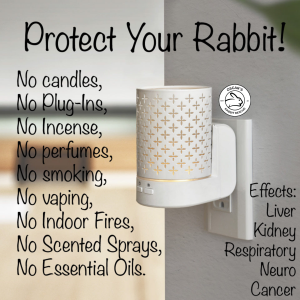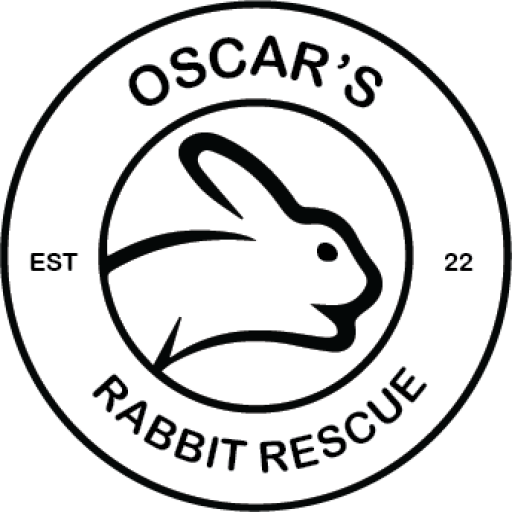Rabbits are chewers, so the most dangerous household hazards are things that they can chew on and hurt themselves, such as electrical cords, toxic woods, toxic plants, plastic, rugs, and blankets. These can become choking hazards or cause digestive issues (e.g., GI stasis, blockage. Other dangers may not cause immediate issues, but they can cause health problems to your rabbit over time.
Rabbit proof your home and monitor your rabbit. It is safest to put them into a safe area using a pen when sleeping.
Wires
Rabbits love to chew! Electrical cords are one of their favorites as they may look like a root or twig. Snipping through a wire happens so often and so quickly! If the cord is plugged in, your rabbit could get electrocuted causing burns or death.
Protect your rabbit by putting your cords up out of reach with command hooks, unplugging them, wrapping them in cord protectors or strips or hard PVP pipe, blocking off areas with fencing (including furniture). Monitor cord protectors as some rabbits will chew through these as well.
Scented Sprays, Oil Diffusers, & Smoke
 Rabbits have delicate respiratory systems. NO scented sprays, diffusers, oils, Febreeze, incense, perfume, or vaping/smoking around your rabbit. Some may cause respiratory irritation while others may cause liver damage, kidney damage, neurological problems, or cancer.
Rabbits have delicate respiratory systems. NO scented sprays, diffusers, oils, Febreeze, incense, perfume, or vaping/smoking around your rabbit. Some may cause respiratory irritation while others may cause liver damage, kidney damage, neurological problems, or cancer.
- Avoid scented litter.
- If you want to use a candle, light it in areas farthest away from your rabbit’s living area.
- If you use oil diffusers, talk to your rabbit-savvy vet about what scents are safe and how to use them safest.
- Never smoke or vape around your rabbit. To do before handling your rabbit if you smoke/vape: Take a shower, brush your teeth, and change your clothing.
- If you want to use essential oils, talk with a rabbit-savvy vet about how to use them safely.
- Avoid smoke from fires.
Slippery Floors & Heights
Rabbits have difficulty gaining traction on slippery floors, and because they have a fragile bone structure. If a rabbit gets scared, or even extremely excited, and quickly run away on a slippery floor it could lead to a back injury and becoming paralyzed in their back legs. Try to use carpet and area rugs where this is possible.
It is great to have an object for your rabbit to jump onto. However, make sure they can safely jump up and down to prevent injured backs or legs. If you are looking to expand their play area, it is safest to create space outward rather than upward.
Cleaning Chemicals
Many store bought cleaners are not safe if they are licked shortly after using. Some also produce a strong scent. Use a pet-safe cleaner, such as making one with equal amounts of water and white vinegar mixed into a spray bottle.
Rescue, found here, is used by many vet offices.
Chlorine bleach may be used to disinfect, but rinse it off and allow time for the scent to dissipate before putting your rabbit back in the area.
Human Foods
Rabbits have a very sensitive digestive track. Therefore, human foods should never be given to a rabbit unless it’s a safe, uncooked vegetable or fruit in moderation. Details about a healthy rabbit diet found here.
Toxic Wood
Protect corners and molding with furniture, rugs, woven grass mats, a hay tub, wood tacking strip, or double-sided tape.
If your rabbit likes to go under your couch, block it off with fencing (example here), a frame made out of scrap lumber, or staple hardware cloth across the underside. Rabbits like to chew furniture when they are bored or upset.
- Cedar wood is the most dangerous. It contains high levels of phenols that can be inhaled by rabbits causing liver complications. Protect your rabbit from all forms of cedar, including furniture. Cedar shavings in litter boxes/enclosures are dangerous.
- Fresh Pine. It contains high levels of phenols and can cause liver complications with prolonged exposure to it. Pine shavings in litter boxes/enclosures are dangerous.
- Painted, Treated, or Stained Wood: All are toxic. Be aware of this if using a hutch, toy, etc.. Some toys are colored with vegetable dye instead which is safe. If the dye on toys runs in water, it is likely made with vegetable dye and is safe. Any other paint should be avoided.
- Dangerous Tree Branches: Yew, Holly, Some Types of Bamboo, Elder Trees
- MDF Boards. This type of material is made up of condensed wood fiber and shavings sealed together with wax and resin. It is commonly used for bookcases and cabinets. MDF boards contain formaldehyde which is toxic to rabbits if they inhale dust particles from it or chew on it.
Safe wood for chewing: Pesticide-free Apple, Pear, and Willow.
Safe wood for building items for rabbits: Untreated, dried, natural pine.
Toxic House Plants
Most house plants should be considered toxic and should be kept out of reach. Detailed listings of toxic plants found here.
Small Appliances
Rabbits are curious and often do not have the instinct to stay away from unsafe appliances like fans and heaters. Be conscious of where you place items such as these.
Sources:
- “9 Household Hazards and Dangers to Pet Rabbits.” The Bunny Lady. https://bunnylady.com/household-hazards-and-dangers-to-pet-rabbits/.
- “10 Types of Wood that are Poisonous for Rabbits.” The Bunny Lady. https://bunnylady.com/poisonous-wood-for-rabbits/.
- Coates, Jennifer DVM. 2020. “How Air Freshners Can Affect Your Pet’s Health.” PetMD by Chewy. https://www.petmd.com/dog/care/air-fresheners-and-pets.
- Flentke, George Ph.D.. “The Dangers of Softwood Shavings.” House Rabbit Society. https://rabbit.org/care/shavings.html
- Harriman, Marinell. “Litterboxes and Liver Disease.” House Rabbit Society. https://rabbit.org/journal/1/liver-disease.html.
- “Housing.” Wisconsin House Rabbit Society. https://wisconsinhrs.org/rabbit-care/housing/.
